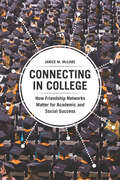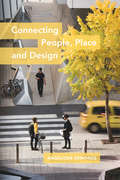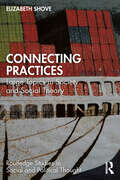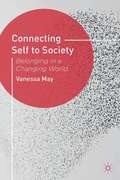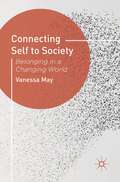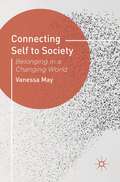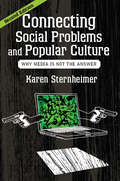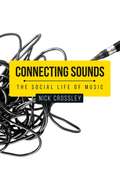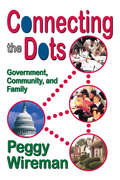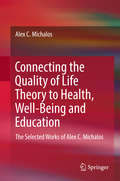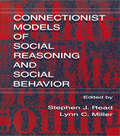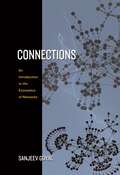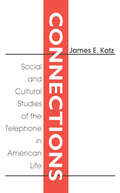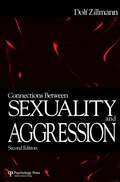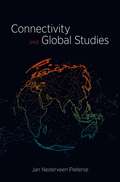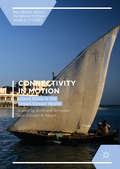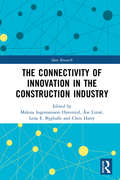- Table View
- List View
Connecting in College: How Friendship Networks Matter for Academic and Social Success
by Janice M. McCabeWe all know that good study habits, supportive parents, and engaged instructors are all keys to getting good grades in college. But as Janice M. McCabe shows in this illuminating study, there is one crucial factor determining a student’s academic success that most of us tend to overlook: who they hang out with. Surveying a range of different kinds of college friendships, Connecting in College details the fascinatingly complex ways students’ social and academic lives intertwine and how students attempt to balance the two in their pursuit of straight As, good times, or both. As McCabe and the students she talks to show, the friendships we forge in college are deeply meaningful, more meaningful than we often give them credit for. They can also vary widely. Some students have only one tight-knit group, others move between several, and still others seem to meet someone new every day. Some students separate their social and academic lives, while others rely on friendships to help them do better in their coursework. McCabe explores how these dynamics lead to different outcomes and how they both influence and are influenced by larger factors such as social and racial inequality. She then looks toward the future and how college friendships affect early adulthood, ultimately drawing her findings into a set of concrete solutions to improve student experiences and better guarantee success in college and beyond.
Connecting in College: How Friendship Networks Matter for Academic and Social Success
by Janice M. McCabeWe all know that good study habits, supportive parents, and engaged instructors are all keys to getting good grades in college. But as Janice M. McCabe shows in this illuminating study, there is one crucial factor determining a student’s academic success that most of us tend to overlook: who they hang out with. Surveying a range of different kinds of college friendships, Connecting in College details the fascinatingly complex ways students’ social and academic lives intertwine and how students attempt to balance the two in their pursuit of straight As, good times, or both. As McCabe and the students she talks to show, the friendships we forge in college are deeply meaningful, more meaningful than we often give them credit for. They can also vary widely. Some students have only one tight-knit group, others move between several, and still others seem to meet someone new every day. Some students separate their social and academic lives, while others rely on friendships to help them do better in their coursework. McCabe explores how these dynamics lead to different outcomes and how they both influence and are influenced by larger factors such as social and racial inequality. She then looks toward the future and how college friendships affect early adulthood, ultimately drawing her findings into a set of concrete solutions to improve student experiences and better guarantee success in college and beyond.
Connecting People, Place and Design
by Angelique EdmondsConnecting People, Place and Design examines the human relationship with place, how its significance has evolved over time and how contemporary systems for participation shape the places around us. This volume examines people, place and design across architecture, design, cultural studies, sociology, political science and philosophy.
Connecting Practices: Large Topics in Society and Social Theory (Routledge Studies in Social and Political Thought)
by Elizabeth ShoveConnecting Practices develops a distinctive method of conceptualising significant trends and global issues including environmental sustainability and inequalities in wealth and health, arguing that these are outcomes of the ways in which social practices interact and combine across space and time. Engaging with the question of how connections are made between practices and how past and present combinations make some futures more likely than others, this book brings practice theory to bear on large problems in society. Richly illustrated with examples from the spreading of germs to the history of shipping containers, this powerful analysis of how societies hang together and how they change will appeal to scholars and students of sociology and social theory.
Connecting Practices: Large Topics in Society and Social Theory (Routledge Studies in Social and Political Thought)
by Elizabeth ShoveConnecting Practices develops a distinctive method of conceptualising significant trends and global issues including environmental sustainability and inequalities in wealth and health, arguing that these are outcomes of the ways in which social practices interact and combine across space and time. Engaging with the question of how connections are made between practices and how past and present combinations make some futures more likely than others, this book brings practice theory to bear on large problems in society. Richly illustrated with examples from the spreading of germs to the history of shipping containers, this powerful analysis of how societies hang together and how they change will appeal to scholars and students of sociology and social theory.
Connecting Self To Society: Belonging In A Changing World (PDF)
by Vanessa MayBelonging' is often overlooked in its relationship to society and social change, and yet it forms the bedrock of how we relate to the world around us. Through the work of Marx, Giddens and Goffman, this book covers the familiar terrain of identity theory, while going beyond it to other sites of identification and social change.
Connecting Self to Society: Belonging in a Changing World
by Vanessa MayBelonging' is often overlooked in its relationship to society and social change, and yet it forms the bedrock of how we relate to the world around us. Through the work of Marx, Giddens and Goffman, this book covers the familiar terrain of identity theory, while going beyond it to other sites of identification and social change.
Connecting Self to Society: Belonging in a Changing World
by Vanessa MayBelonging is often overlooked in its relationship to society and social change, and yet it forms the bedrock of how we relate to the world around us. Through the work of Marx, Giddens and Goffman, this book covers the familiar terrain of identity theory, while going beyond it to other sites of identification and social change.
Connecting Social Problems and Popular Culture: Why Media is Not the Answer
by Karen SternheimerIs violence on the streets caused by violence in video games? Does cyber-bullying lead to an increase in suicide rates? Are teens promiscuous because of Teen Mom? As Karen Sternheimer clearly demonstrates, popular culture is an easy scapegoat for many of society's problems, but it is almost always the wrong answer. Now in its second edition, Connecting Social Problems and Popular Culture goes beyond the news-grabbing headlines claiming that popular culture is public enemy number one to consider what really causes the social problems we are most concerned about. The sobering fact is that a "media made them do it" explanation fails to illuminate the roots of social problems like poverty, violence, and environmental degradation. Sternheimer's analysis deftly illustrates how welfare "reform," a two-tiered health care system, and other difficult systemic issues have far more to do with our contemporary social problems than Grand Theft Auto or Facebook. The fully-revised new edition features recent moral panics (think sexting and cyberbullying) and an entirely new chapter exploring social media. Expanded discussion of how we understand society's problems as social constructions without disregarding empirical evidence, as well as the cultural and structural issues underlying those ills, allows students to stretch their sociological imaginations.
Connecting sounds: The social life of music (G - Reference, Information And Interdisciplinary Subjects Ser.)
by Nick CrossleyCrossley argues that music is a form of social interaction, interwoven in the fabric of society and in constant interplay with its other threads. Musical interactions are often also economic interactions, for example, and sometimes political interactions. They can be forms of identity work, for both individuals and collectives, contributing to the reproduction or bridging of social divisions. Successive chapters of the book track and explore these interplays, in each case combining a critical consideration of existing literature with the development of an original, ‘relational’ approach to music sociology. The result is a grand sociological vision of music which captures not only music’s context but ‘the music itself’. The book will appeal to social scientists, musicologists and cultural scholars more widely.
Connecting sounds: The social life of music (G - Reference, Information And Interdisciplinary Subjects Ser.)
by Nick CrossleyCrossley argues that music is a form of social interaction, interwoven in the fabric of society and in constant interplay with its other threads. Musical interactions are often also economic interactions, for example, and sometimes political interactions. They can be forms of identity work, for both individuals and collectives, contributing to the reproduction or bridging of social divisions. Successive chapters of the book track and explore these interplays, in each case combining a critical consideration of existing literature with the development of an original, ‘relational’ approach to music sociology. The result is a grand sociological vision of music which captures not only music’s context but ‘the music itself’. The book will appeal to social scientists, musicologists and cultural scholars more widely.
Connecting the Dots: Government, Community, and Family
by Peggy WiremanDespite its size and social diversity, the United States is one nation, and what happens in one city or neighborhood ultimately affects all Americans. "Connecting the Dots" addresses the complex relationships between family and community, and between community and other players affecting family and community life, including the private sector, government, nonprofit groups, and religious organizations. Contrary to much rhetoric, Wireman argues that America does not suffer from a loss of family values, but from a shift in business practices and public commitments. The American dream of work hard, buy a home, and give your children a better life is no longer realistic for millions of workers, both white-collar and blue-collar. At an individual level, millions of Americans face significant challenges as they go about trying to meet the everyday responsibilities of earning an income, feeding their families, maintaining their health, finding housing, handling everyday household chores, and caring for their children. Besides identifying top-down structures, laws, and attitudes that create a supportive context for family life, the book includes bottom-up anecdotal examples to ground its policy-oriented discussion. It also provides statistical data needed to develop realistic solutions. Wireman examines diversity as well, since how America handles racial and ethnic differences remains crucial to its future. She discusses ways in which communities have created social capital, community cohesion, and local organizational ability. Wireman provides a framework for policymakers, local community leaders, and neighborhood activists to use in analyzing their situations and selecting the best approach; she also describes what various players can and must do to uphold the American dream. "Connecting the Dots" will be of keen interest to sociologists, political scientists, economists, and social workers.
Connecting the Dots: Government, Community, and Family
by Peggy WiremanDespite its size and social diversity, the United States is one nation, and what happens in one city or neighborhood ultimately affects all Americans. "Connecting the Dots" addresses the complex relationships between family and community, and between community and other players affecting family and community life, including the private sector, government, nonprofit groups, and religious organizations. Contrary to much rhetoric, Wireman argues that America does not suffer from a loss of family values, but from a shift in business practices and public commitments. The American dream of work hard, buy a home, and give your children a better life is no longer realistic for millions of workers, both white-collar and blue-collar. At an individual level, millions of Americans face significant challenges as they go about trying to meet the everyday responsibilities of earning an income, feeding their families, maintaining their health, finding housing, handling everyday household chores, and caring for their children. Besides identifying top-down structures, laws, and attitudes that create a supportive context for family life, the book includes bottom-up anecdotal examples to ground its policy-oriented discussion. It also provides statistical data needed to develop realistic solutions. Wireman examines diversity as well, since how America handles racial and ethnic differences remains crucial to its future. She discusses ways in which communities have created social capital, community cohesion, and local organizational ability. Wireman provides a framework for policymakers, local community leaders, and neighborhood activists to use in analyzing their situations and selecting the best approach; she also describes what various players can and must do to uphold the American dream. "Connecting the Dots" will be of keen interest to sociologists, political scientists, economists, and social workers.
Connecting the Quality of Life Theory to Health, Well-being and Education: The Selected Works of Alex C. Michalos
by Alex C. MichalosThis volume connects aspects of personal health, overall well-being, and education to quality of life. It includes discussions of Galen’s and Harvey’s views of the movement of blood in human bodies, and differences in the research traditions of social indicators research and health-related quality of life research. It examines determinants of health and quality of life in a variety of populations, including the residents of the Bella Coola Valley of British Columbia, aboriginal residential school survivors in Canada, and diabetics versus non-diabetics. It describes relations between health survey and patients’ medical chart reviews, the health and quality of life of older people, and the difference between good health and a good life. Other topics explored are student quality of life, comparisons of the quality of life of students, aboriginal and unemployed people, the impact of education on happiness and well-being, and liberal education. In addition, the volume presents Einstein’s views of ethics and science, and unacknowledged authorship in scholarly publications. The final chapter gives a historical review of quality of life research in Canada over the past fifty years.
Connectionist Models of Social Reasoning and Social Behavior
by Stephen J. Read Lynn C. MillerAlthough neural network models have had a dramatic impact on the cognitive and brain sciences, social psychology has remained largely unaffected by this intellectual explosion. The first to apply neural network models to social phenomena, this book includes chapters by nearly all of the individuals currently working in this area. Bringing these various approaches together in one place, it allows readers to appreciate the breadth of these approaches, as well as the theoretical commonality of many of these models. The contributors address a number of central issues in social psychology and show how these kinds of models provide insight into many classic issues. Many chapters hint that this approach provides the seeds of a theoretical integration that the field has lacked. Each chapter discusses an explicit connectionist model of a central problem in social psychology. Since many of the contributors either use a standard architecture or provide a computer program, interested readers, with a little work, should be able to implement their own variations of models. Chapters are devoted to the following topics and models: * the learning and application of social categories and stereotypes; * causal reasoning, social explanation, and person perception; * personality and social behavior; * classic dissonance phenomena; and * belief change and the coherence of large scale belief systems.
Connectionist Models of Social Reasoning and Social Behavior
by Stephen John Read Lynn C. MillerAlthough neural network models have had a dramatic impact on the cognitive and brain sciences, social psychology has remained largely unaffected by this intellectual explosion. The first to apply neural network models to social phenomena, this book includes chapters by nearly all of the individuals currently working in this area. Bringing these various approaches together in one place, it allows readers to appreciate the breadth of these approaches, as well as the theoretical commonality of many of these models. The contributors address a number of central issues in social psychology and show how these kinds of models provide insight into many classic issues. Many chapters hint that this approach provides the seeds of a theoretical integration that the field has lacked. Each chapter discusses an explicit connectionist model of a central problem in social psychology. Since many of the contributors either use a standard architecture or provide a computer program, interested readers, with a little work, should be able to implement their own variations of models. Chapters are devoted to the following topics and models: * the learning and application of social categories and stereotypes; * causal reasoning, social explanation, and person perception; * personality and social behavior; * classic dissonance phenomena; and * belief change and the coherence of large scale belief systems.
Connections: An Introduction to the Economics of Networks
by Sanjeev GoyalNetworks pervade social and economic life, and they play a prominent role in explaining a huge variety of social and economic phenomena. Standard economic theory did not give much credit to the role of networks until the early 1990s, but since then the study of the theory of networks has blossomed. At the heart of this research is the idea that the pattern of connections between individual rational agents shapes their actions and determines their rewards. The importance of connections has in turn motivated the study of the very processes by which networks are formed. In Connections, Sanjeev Goyal puts contemporary thinking about networks and economic activity into context. He develops a general framework within which this body of research can be located. In the first part of the book he demonstrates that location in a network has significant effects on individual rewards and that, given this, it is natural that individuals will seek to form connections to move the network in their favor. This idea motivates the second part of the book, which develops a general theory of network formation founded on individual incentives. Goyal assesses the robustness of current research findings and identifies the substantive open questions. Written in a style that combines simple examples with formal models and complete mathematical proofs, Connections is a concise and self-contained treatment of the economic theory of networks, one that should become the natural source of reference for graduate students in economics and related disciplines.
Connections: An Introduction to the Economics of Networks
by Sanjeev GoyalNetworks pervade social and economic life, and they play a prominent role in explaining a huge variety of social and economic phenomena. Standard economic theory did not give much credit to the role of networks until the early 1990s, but since then the study of the theory of networks has blossomed. At the heart of this research is the idea that the pattern of connections between individual rational agents shapes their actions and determines their rewards. The importance of connections has in turn motivated the study of the very processes by which networks are formed. In Connections, Sanjeev Goyal puts contemporary thinking about networks and economic activity into context. He develops a general framework within which this body of research can be located. In the first part of the book he demonstrates that location in a network has significant effects on individual rewards and that, given this, it is natural that individuals will seek to form connections to move the network in their favor. This idea motivates the second part of the book, which develops a general theory of network formation founded on individual incentives. Goyal assesses the robustness of current research findings and identifies the substantive open questions. Written in a style that combines simple examples with formal models and complete mathematical proofs, Connections is a concise and self-contained treatment of the economic theory of networks, one that should become the natural source of reference for graduate students in economics and related disciplines.
Connections: Social and Cultural Studies of the Telephone in American Life
by James E. KatzPerhaps no other technology has done so much to so many, but been studied by so few, as the telephone. Even as its physical size diminishes, the telephone is becoming more important. In Connections, now available in paperback, James E. Katz gives greater visibility to this important element in modern life.Katz examines how the telephone reveals gender relations in a way not predicted by feminist theories, how it can be used to protect and invade personal privacy, and how people harness telephone answering machines to their advantage. Katz's inquiry reports on obscene phone calls, the abuses of caller-ID technology, and attitudes toward voice mail. National data about cellular telephones are presented to show the extent to which beepers and car phones have become status symbols.Katz ranges from microsocial interaction to macrosocial theory, and from the family and personal levels of organization to that of large-scale industrial bureaucracies. The result of this investigation is a compelling mosaic spanning sociology and psychology, and organization and communication studies. These arresting portraits will offer profound insight to historians, students of American culture, and those concerned about the nature and direction of the emerging information society.
Connections: Social and Cultural Studies of the Telephone in American Life
by James E. KatzPerhaps no other technology has done so much to so many, but been studied by so few, as the telephone. Even as its physical size diminishes, the telephone is becoming more important. In Connections, now available in paperback, James E. Katz gives greater visibility to this important element in modern life.Katz examines how the telephone reveals gender relations in a way not predicted by feminist theories, how it can be used to protect and invade personal privacy, and how people harness telephone answering machines to their advantage. Katz's inquiry reports on obscene phone calls, the abuses of caller-ID technology, and attitudes toward voice mail. National data about cellular telephones are presented to show the extent to which beepers and car phones have become status symbols.Katz ranges from microsocial interaction to macrosocial theory, and from the family and personal levels of organization to that of large-scale industrial bureaucracies. The result of this investigation is a compelling mosaic spanning sociology and psychology, and organization and communication studies. These arresting portraits will offer profound insight to historians, students of American culture, and those concerned about the nature and direction of the emerging information society.
Connections Between Sexuality and Aggression
by Dolf ZillmannThis is the only available comprehensive monograph on interrelations and interdependencies between agonistic and sexual behaviors. Integrating theory and research from biology, anthropology, neurophysiology, endocrinology, psychophysiology, and psychology, this book focuses on the mechanisms that govern the mutual influences between sexuality and aggression in behavior sequences and especially in admixtures of aggressive-sexual behaviors. This book places human agonistic and sexual behaviors into an evolutionary context. It offers a Weltbild of human aggressive-sexual behaviors by tracing their biological and developmental origins and examines the plasticity and manipulability of connections between agonistic and sexual behaviors. Strategies for the maximization of sexual pleasures are elaborated , and intervention treatments--aiming at the control of violent behaviors--are considered. Coercive sexuality is given special attention. Prevalent motive ascriptions to rape are called into question and the motivation that dominates rape is reinterpreted in the context of pleasure maximization. This second edition brings the coverage of pertinent research up to date. It advances the exploration of aggressive-sexual behaviors by further integrating the research contributions from various disciplines, and by refining and unifying theory capable of explaining the behavioral phenomena under consideration. COPY FOR ZILLMANN MAILER Zillmann examines issues such as sexual access through aggression, the involvement of agonistic behavior within sexuality, sex-aggression fusion, the consequences of anticipatory imagination concerning sexuality, and aspects of libido loss due to excitatory habituation. This book also: * traces connection between sexuality and aggression in nonhuman species, especially in nonhuman primates, * subjects human behavior to comparative and evolutionary analysis, * examines connectedness in neurological and endocrinological terms, * details both central and autonomic commonalities between sexual and aggressive behaviors, * outlines sexual dimorphism and chromosomal-endocrine aberrations, * pays special attention to adrenal commonalities in sexual and aggressive behaviors and the fusion of these behaviors, and * examines aggressive-sexual connectedness in the analysis of motivation and emotion. Zillmann finally proposes new explanations for the numerous documented associations between sexuality and aggression. These proposals combine biological, neuroendocrine, autonomic, and cognitive aspects of aggressive and sexual behaviors. A trichotomy of excitatory interdependencies is developed for fight, flight, and coition. In the nomenclature of emotion, this trichotomy concerns the interdependencies between aggressiveness, fear, and sexual impulsion. A considerable amount of research evidence is aggregated in support of these interdependencies. The author ultimately examines the exploitation of the existing connections between sexual and aggressive behaviors, especially the exploitation that serves the enhancement of sexual pleasure. In this context he arrives at novel, and perhaps distressing, characterizations of sexual coercion. However, he also explores sexual boredom and discusses remedies in the framework of his theorizing. Last but not least, sexual aggression, and sexual and aggressive behaviors independently, are placed into an evolutionary context. Recognition and acknowledgment of the archaic nature of many aspects of sexual and aggressive behaviors, in contrast to the comparatively vernal development of behavior-guiding contemplation, leads him to a unique and provocative proposal of the function of aggression in the realm of sexuality.
Connections Between Sexuality and Aggression
by Dolf ZillmannThis is the only available comprehensive monograph on interrelations and interdependencies between agonistic and sexual behaviors. Integrating theory and research from biology, anthropology, neurophysiology, endocrinology, psychophysiology, and psychology, this book focuses on the mechanisms that govern the mutual influences between sexuality and aggression in behavior sequences and especially in admixtures of aggressive-sexual behaviors. This book places human agonistic and sexual behaviors into an evolutionary context. It offers a Weltbild of human aggressive-sexual behaviors by tracing their biological and developmental origins and examines the plasticity and manipulability of connections between agonistic and sexual behaviors. Strategies for the maximization of sexual pleasures are elaborated , and intervention treatments--aiming at the control of violent behaviors--are considered. Coercive sexuality is given special attention. Prevalent motive ascriptions to rape are called into question and the motivation that dominates rape is reinterpreted in the context of pleasure maximization. This second edition brings the coverage of pertinent research up to date. It advances the exploration of aggressive-sexual behaviors by further integrating the research contributions from various disciplines, and by refining and unifying theory capable of explaining the behavioral phenomena under consideration. COPY FOR ZILLMANN MAILER Zillmann examines issues such as sexual access through aggression, the involvement of agonistic behavior within sexuality, sex-aggression fusion, the consequences of anticipatory imagination concerning sexuality, and aspects of libido loss due to excitatory habituation. This book also: * traces connection between sexuality and aggression in nonhuman species, especially in nonhuman primates, * subjects human behavior to comparative and evolutionary analysis, * examines connectedness in neurological and endocrinological terms, * details both central and autonomic commonalities between sexual and aggressive behaviors, * outlines sexual dimorphism and chromosomal-endocrine aberrations, * pays special attention to adrenal commonalities in sexual and aggressive behaviors and the fusion of these behaviors, and * examines aggressive-sexual connectedness in the analysis of motivation and emotion. Zillmann finally proposes new explanations for the numerous documented associations between sexuality and aggression. These proposals combine biological, neuroendocrine, autonomic, and cognitive aspects of aggressive and sexual behaviors. A trichotomy of excitatory interdependencies is developed for fight, flight, and coition. In the nomenclature of emotion, this trichotomy concerns the interdependencies between aggressiveness, fear, and sexual impulsion. A considerable amount of research evidence is aggregated in support of these interdependencies. The author ultimately examines the exploitation of the existing connections between sexual and aggressive behaviors, especially the exploitation that serves the enhancement of sexual pleasure. In this context he arrives at novel, and perhaps distressing, characterizations of sexual coercion. However, he also explores sexual boredom and discusses remedies in the framework of his theorizing. Last but not least, sexual aggression, and sexual and aggressive behaviors independently, are placed into an evolutionary context. Recognition and acknowledgment of the archaic nature of many aspects of sexual and aggressive behaviors, in contrast to the comparatively vernal development of behavior-guiding contemplation, leads him to a unique and provocative proposal of the function of aggression in the realm of sexuality.
Connectivity and Global Studies
by Jan Nederveen PieterseThis textbook provides readers with evocative and analytical accounts of social processes that are linked to globalization and connectivity, which includes a wide range of multi-centred connections in history, DNA analysis, technology, art, populism and political economy. Rather than globalization, Nederveen Pieterse focuses on connectivity. His approach to globalization differs from both structuralist accounts of the world-system, and the institutionally-centred focus of much work in international studies. This synthesis will provide a new resource to reconstruct theoretical approaches to globalization and global studies. Fluently written, clearly organized and with an interdisciplinary approach, the book will be accessible to upper division undergraduates and graduates in social sciences, including students and researchers from the fields of sociology, politics, political economy, development studies and international relations.
Connectivity in Motion: Island Hubs in the Indian Ocean World (Palgrave Series in Indian Ocean World Studies)
by Burkhard Schnepel Edward A. AlpersThis original collection brings islands to the fore in a growing body of scholarship on the Indian Ocean, examining them as hubs or points of convergence and divergence in a world of maritime movements and exchanges. Straddling history and anthropology and grounded in the framework of connectivity, the book tackles central themes such as smallness, translocality, and “the island factor.” It moves to the farthest reaches of the region, with a rich variety of case studies on the Swahili-Comorian world, the Maldives, Indonesia, and more. With remarkable breadth and cohesion, these essays capture the circulations of people, goods, rituals, sociocultural practices, and ideas that constitute the Indian Ocean world. Together, they take up “islandness” as an explicit empirical and methodological issue as few have done before.
The Connectivity of Innovation in the Construction Industry (Spon Research)
by Chris Harty Malena Ingemansson Havenvid Åse Linné Lena E. BygballeThe construction industry is currently experiencing accelerating developments concerning societal demands along with project complexity, internationalization and digitalization. In an attempt to grasp the consequences of these demands on productivity and innovation, this edited book addresses how innovation is likely to take place with a more long-term perspective on the construction sector. While existing literature focuses on organizational discontinuity and fragmentation as the main reasons for the apparent lack of innovation in the industry, this book highlights the connectivity of construction actors, resources and activities as fundamental for understanding how innovation takes place.Through 15 empirically grounded chapters, the book shows how innovation is part of construction processes on various levels, including project, firm and industry, and that these innovation processes are characterized by organizational and technological connectivity over time. Written by European business management scholars, the chapters cover empirical cases and examples from both a multi-organizational and a multi-international perspective in terms of covering the viewpoints of different industry actors and the contexts of several different European countries including: Sweden, Norway, the UK, Italy, France, Hungary and Poland. By illustrating how connectivity is part of innovation processes in the creation of single-product innovations, of various innovations within and across projects, as well as a fundamental aspect of the processes in which innovations cross nations, the book provides a new angle on how to understand construction innovation and where the industry might (or needs to) be heading next. This book is essential reading for anyone interested in construction management, project management, engineering management, innovation studies, business and management studies.
